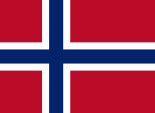Norwegisches Antarktisterritorium |
|
|
|
| Übersicht – Contents: | |
Diese Seite ist Teil des Projektes
Norwegisches Antarktisterritorium |
|
|
|
| Übersicht – Contents: | |
| Flagge – Flag: | |
| Das Land hat keine eigene Flagge. Es wird die Flagge Norwegens verwendet: | The country has no own flag. There is in use the flag of Norway: |
 |
National- und Handelsflagge von Norwegen – national and merchant flag of Norway, Seitenverhältnis – ratio = 8:11, Quelle/Source, nach/by: Corel Draw 4   |
| Zahlen und Fakten – Numbers and Facts: | |
|
|
|
|
|
|
| 1820 ·
die russischen Seefahrer Bellingshausen und Lasarew erforschen die Küste des
späteren Königin-Maud-Landes 1831 · der englische Seefahrer Biscoe erforscht die Küste des späteren Königin-Maud-Landes 1925 · deutsche Antarktisexpedition unter Dr. Albert Merz 1931 · der Norweger Rilser-Larsen erforscht die Küste des späteren Königin-Maud-Landes 1938 · Norwegen erhebt Anspruch auf das spätere Königin-Maud-Land zw. 20° w.L. und 45° ö.L., den sogenannten Bouvet Sektor 1938–1939 · Deutsche Antarktische Expedition unter Kapitän Ritscher, völkerrechtlich wirksame Inbesitznahme von Neuschwabenland für das Deutsche Reich 1945 · das Deutsche Reich verzichtet auf seine antarktischen Gebiete, Norwegen erhebt Anspruch 1952 · der Bundesrepublik Deutschland wird das Recht eingeräumt, das mit der Entdeckung verbundene Recht zur geographischen Namensgebung in Neuschwabenland wahrzunehmen 01.12.1959 · Antarktisvertrag über friedliche Nutzung der Antarktis, Gebietsansprüche bleiben unberührt, der Bouvet-Sektor wird Königin-Maud-Land genannt, die Namen Neuschwabenland, Schirmacher-Oase, Ritscher-Hochland, Mühlig-Hofmann-Gebirge, Wohlthat-Massiv bleiben unberührt |
| 1820 ·
the Russian seafarers Bellingshausen and Lasarew explore the coast of the
future Queen Maud Land 1831 · the English seafarer Biscoe explores the coast of the future Queen Maud Land 1925 · German antarctic expedition under Dr. Albert Merz 1931 · the Norwegian Rilser-Larsen explores the coast of the future Queen Maud Land 1938 · Norway lays claim to what later became Queen Maud Land between 20° W and 45° E, the so named Bouvet Sector 1938–1939 · German antarctic expedition under Captain Ritscher, according to the international law effective appropriation of Neuschwabenland for the German Empire 1945 · the German Empire renounces its antarctic territories, Norway words claims 1952 · the Federal Republic of Germany gets granted the law for the by discovery given right for the awarding of geographical names 1st of December 1959 · Antarctic Treaty for the peaceful exploitation of the Antarctic, claims for territories remain untouched, the Bouvet Sector gets the name Queen Maud Land, the names Neuschwabenland, Schirmacher-Oase, Ritscher-Hochland, Mühlig-Hofmann-Gebirge, Wohlthat-Massiv remain untouched |
| Quelle/Source: Atlas zur Geschichte, Wikipedia (DE) |
| Der Name "Königin-Maud-Land" bezieht sich auf die norwegische Königin Maud (1869–1938). "Bouvet Sektor" geht auf die 1 600 km vor der Küste gelegene norweg. Insel "Bouvet" zurück. | The name
"Queen Maud Land" points to the Norwegian Queen Maud (1869–1938).
"Bouvet-Sektor" goes back to the 1 000 mi. in front of the coast situated
Norwegian island "Bouvet". |